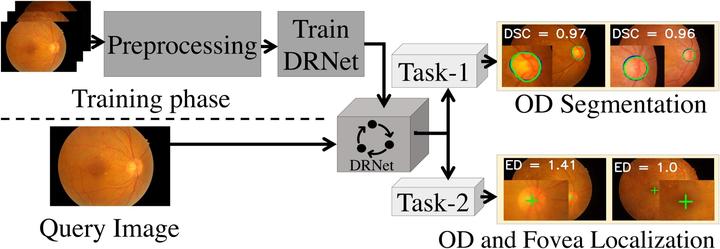DRNet: Segmentation and localization of optic disc and Fovea from diabetic retinopathy image
 Workflow of the proposed DRNet
Workflow of the proposed DRNet
Abstract
This article introduces a novel end-to-end encoder-decoder network, DRNet, explicitly designed for the segmentation and localization of OD and Fovea centers. In our DRNet, we propose a skip connection, named residual skip connection, to compensate for the spatial information lost due to pooling in the encoder. Unlike the earlier skip connection in the UNet, the proposed skip connection does not directly concatenate low-level feature maps from the encoder’s beginning layers with the corresponding same-scale decoder. We validate DRNet using different publicly available datasets, such as IDRiD, RIMONE, DRISHTI-GS, and DRIVE for OD segmentation; IDRiD and HRF for OD center localization; and IDRiD for Fovea center localization. The proposed DRNet, for OD segmentation, achieves mean Intersection over Union (mIoU) of 0.845, 0.901, 0.933, and 0.920 for IDRiD, RIMONE, DRISHTI-GS, and DRIVE, respectively. Our OD segmentation result, in terms of mIoU, outperforms the state-of-the-art results for IDRiD and DRIVE datasets, whereas it outperforms state-of-the-art results concerning mean sensitivity for RIMONE and DRISHTI-GS datasets. The DRNet localizes the OD center with mean Euclidean Distance (mED) of 20.23 and 13.34 pixels, respectively, for IDRiD and HRF datasets; it outperforms the state-of-the-art by 4.62 pixels for IDRiD dataset. The DRNet also successfully localizes the Fovea center with mED of 41.87 pixels for the IDRiD dataset, outperforming the state-of-the-art by 1.59 pixels for the same dataset. The proposed DRNet, for OD segmentation, achieves mean Intersection over Union (mIoU) of 0.845, 0.901, 0.933, and 0.920 for IDRiD, RIMONE, DRISHTI-GS and DRIVE, respectively. Our OD segmentation result, in terms of mIoU, outperforms the state-of-the-art results for IDRiD and DRIVE datasets, whereas it outperforms state-of-the-art results concerning mean sensitivity for RIMONE and DRISHTI-GS datasets. The DRNet localizes the OD center with mean Euclidean Distance (mED) of 20.23 and 13.34 pixels, respectively, for IDRiD and HRF datasets; it outperforms the state-of-the-art by 4.62 pixels for IDRiD dataset. The DRNet also successfully localizes the Fovea center with mED of 41.87 pixels for the IDRiD dataset, outperforming the state-of-the-art by 1.59 pixels for the same dataset.